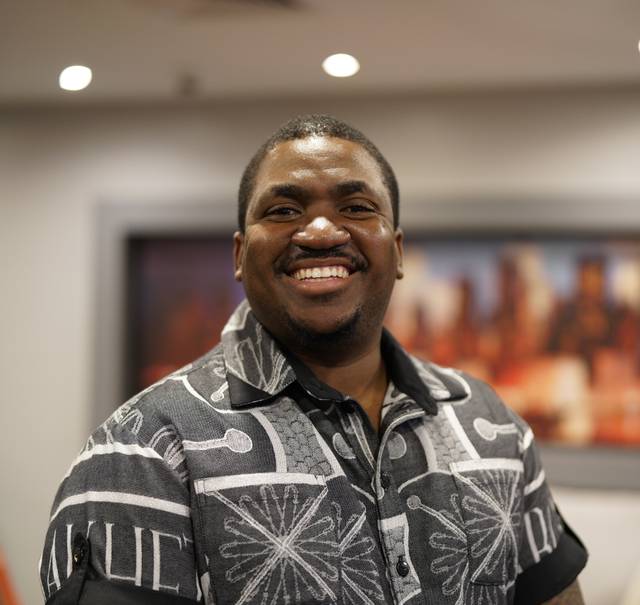
Alumni on the Move
Pitching with purpose: Lessons from my Äänit Prize journey
Koaile Monaheng (Lesotho & University of Cape Town, 2020), winner of the 2022 Äänit Prize, shares key insights on how to deliver a powerful pitch for the Äänit Prize.
When Kevin and I turned on our cameras to pitch Khantša for the Mandela Rhodes Foundation’s Äänit Prize in 2022, I knew that I was carrying more than an idea. I was carrying the hopes of rural communities in Lesotho still living in the dark. Winning the prize was a humbling recognition of that journey, but more than anything, it taught me that successful pitching is an art scholars can learn.
Tell your story (as it is)
Data is important, but stories are what people remember. When we pitched, I didn’t open with technical details about solar systems. I began with a real story, a real rural village where children were studying by candlelight, matriculants were using the sun as timer and clinics operated without reliable power. Stories like these make your project human. They remind people why it matters. When we state that “energy access for all is a precondition for ensuring well-being and dignified lives for all our people” we were not theorising. This was not something we read from a book or study; we had experienced it first hand by spending time in the communities we served. The focal point of the Äänit Prize is in its collective responsibility to be effective and that resonated powerfully.
Keep it simple
Your presentation will be evaluated by judges and experts from various fields, so your messages should be clear and easily understood by all. One thing I pride myself on and is the ability to ensure that the message is consistent from boardrooms to rural villages. In Prof. Ndebele’s words ‘’what sets us apart as Mandela Rhodes is our ability to hold complexity” which means we often confront complicated ideas. The key here is also crucially, how come out on the other side with these ideas simpler and more palatable without them losing their meaning. Therefore, pitching requires clarity. Instead of saying “we’re installing decentralized photovoltaic solar systems for rural healthcare facilities,” I explained; “we’re giving power to five clinics that serve 60,000 people.” The simpler your message, the more powerful it becomes.
Stay true to your why. By all means necessary
Your pitch should go beyond the mechanics of what you’re doing to answer why it matters. Khantša isn’t only about electricity—it’s about dignity. It’s about mothers giving birth safely at night, children accessing digital learning tools, and entire communities being included in a just energy transition. It is about the co-creation of solutions that imbeds you into the community building process by harnessing the power of indigenous knowledge, technology and oral traditions that are passed down from generations underpinned by values of respect and trust. Our idea is grounded in our core values of equality, dignity, and equal opportunity. These non-negotiable values exposed us to the cross-cutting demand and the depth of need related to energy access, It has allowed us to defend these values in our intervention at every step to ensure that we do not compromise our why. We are intentional with working with people who are aligned with our values. So, show the transformation your idea creates, not just the process.
Be confident – you’ve got this
You’re no longer a super nervous perspective scholar sitting in Madiba’s Bishopscourt boardroom, you’re an MRF Alum – let that confidence shine through. That doesn’t mean leaving the preparation behind, its powerful blend of both. I practiced my pitch so many times that I could deliver it anywhere, in any format, in any language I could speak at the time. That practice gave me confidence to handle questions from the judges and adapt when needed. Preparation frees you to focus less on remembering your words and more on connecting with your audience. We rehearsed the scene on camera, encountered several mistakes, and repeated the process multiple times. Ultimately, we compiled these clips into an entire blooper video, which was released following the final result. Looking back, it also just reinforced how committed we were to the process of authentic story telling.
Align passion with practicality
We had already done the work, we had our proof concept, our intervention worked as well as created real change and now we were ready make the leap to the towards actualizing our vision to “light up Lesotho’s the future.” The question “is this scalable?” comes to mind. Before you panic – relax. Be honest about the context you are operating in and remember passion must be backed by evidence. We’re operating in a least developed country with dispersed rural communities, limited infrastructure, and resource constraints so for us, impact preceded scale (we only realized just how much later). This allowed us to pivot our focus towards on maximizing meaningful impact for the communities we could reach today, while laying the foundation for future growth. A bold vision is inspiring, but demonstrating tangible results, even on a smaller scale builds credibility and shows that your idea can deliver real change. Scaling will follow, but first, we needed to ensure that every project we implement truly transforms lives.
I should’ve opened with the fact that I often consider myself an accidental entrepreneur. All I was ever interested in was transforming lives, so I consider entrepreneurship as a vessel for that vision, not the gaol. For Khantša, our work is anchored in a simple Basotho proverb, “Motho ke motho ka batho” which means “I am because you are.” To be Mosotho is to embody an ancient practice of Basotho love and hospitality; in offering your best house to a guest and an evening meal without the slightest thought that you are doing anything extraordinary.






